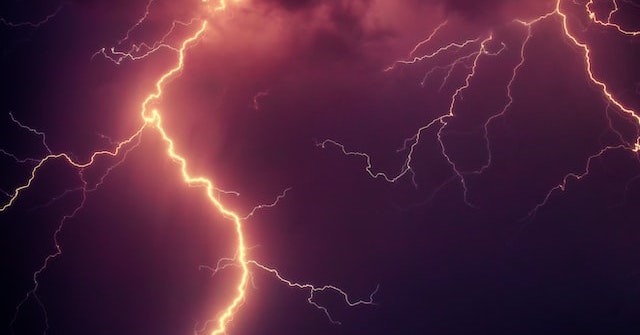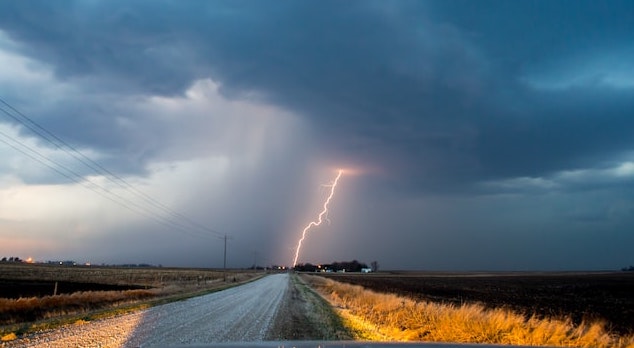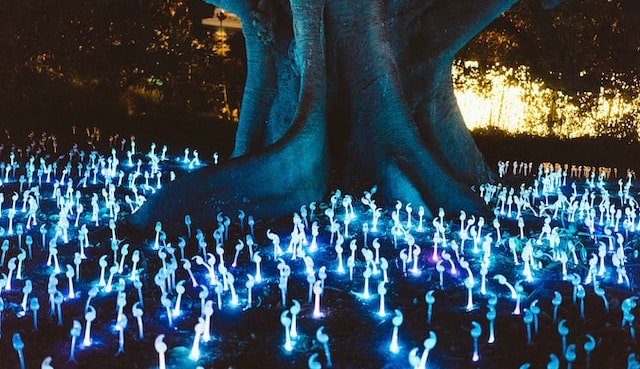It’s enough to make you snuggle down in a onesie and hibernate, grizzly style, until spring.

The Calm After the Storm
But, when the storm finally clears and we are treated to a fresh autumnal day, with crunchy copper leaves and the bluest of blue skies there really is nothing better. And, if you’re wandering the hills and dales (or local park) on a day like this, you might notice that the mushroom population has, well, mushroomed.

Sure, ‘tis the season after all. However, that’s not the only reason why the fungi may be that extra bit bountiful. It could also be that aforementioned storm. Yep, as the actually pretty ancient legend goes, lightning makes mushrooms multiply.
Mushroom Farming Folklore
Yes, like Dr, Frankenstein animating his poor ‘ol monster, it seems like mushrooms also harness the power of nature’s electricity.

This folklore has long been known, especially by Japanese farmers, who always welcomed storm clouds gathering in the sky. They knew that soon their mushroom crops would boom. And good thing too, as mushrooms are a staple part of the Japanese diet.
However, today supply is not equal to demand, with 50,000 tons of mushrooms being imported yearly, on top of the crops grown at home. This has caused researchers to look to the folklore of the land, in an effort to increase fungi fulfilment.
Multiplying Mushrooms
As part of a years-long study researchers at Iwate University in northern Japan have been blasting different species of shroom with artificially induced lightning. These mushrooms are grown in lab-based garden plots. This makes it easy to measure if the electricity has caused them to multiply.

And, whaddya know? Their findings show that jolts of electricity (at a strength equal to lightning) can more than double the production of certain mushroom species when compared to traditional cultivation methods. Of the ten mushroom species tried at the time, eight were receptive to the multiplying effects of lightning. Koichi Takaki an associate professor at the university said;
“We saw the best effects in shiitake and nameko mushrooms. We also tested reishi mushrooms, which are not edible but are used in certain types of traditional Chinese medicine,”
Speeding Up the Cultivation Process
Cultivating shiitake mushrooms is usually a year long process. Firstly the hyphae of the mushroom must be grown in hardwood logs which are kept in beds. Then farmers submerge the logs in water for 1 to 2 days, and then they are beaten by a machine (the logs not the farmers.) This works to sort of ‘trip’ the fungi into its reproductive phase, producing those tasty shiitake we know and love.
In Takaki’s studies, a direct current was run through the shiitake’s log, which within days caused increased yields. It was definitely much faster than beating the log with a robot for months on end.
“We use high voltage electric shock as stimulation to change the mushroom growth state from vegetative to reproductive growth of fruiting bodies.”
‘A Sudden Increase’
Takaki and co. hypothesized that mushrooms near a lightning strike zone are stimulated by a lesser charge running through the soil, rather than from a direct hit, as that would fry the mushrooms (and not in a tasty way!) This is why the current was run through the log.
The tests found that the mushrooms optimum yield was achieved when they were exposed to between 50,000 and 1000,000 volts for one ten-millionth of a second. The shiitake mushroom yield doubled and the nameko mushroom yielded 80% more under these conditions. Phew!
Takaki said; “The reaction of the mushrooms to this sudden burst of energy is initially to decrease the proteins and enzymes secreted by their hyphae, followed by a sudden increase.”

Pretty electrifying stuff! But Takaki was not done. The logs they were working with had a current run directly through them — but the desired increase in yield was also seen in mushroom populations located miles away from where natural lightning strikes happened to hit. Why?
Takaki proposed that it was not purely the electric shocks triggering the mushroom growth, but that there must be other physical effects that act as part of the process. (Perhaps a bit like the entourage effect but with lightning?) Takaki and his team decided to look into the effects of more naturalistic, indirect electricity strikes on mushroom growth.
Aiming for a Near Miss
On day one they took logs that were pre-prepped for the stimulation process and submerged them in water for 24 hours. They then placed them 3 meters away from an impulse voltage generator. They programmed the electrodes to generate 3-4 strikes, the average for an electrical storm cloud. By days 9, 11 and 13 they were able to harvest mushrooms with caps of more than 50mm in diameter. The logs placed 3m away from the lighting strikes produced twice as many mushrooms as the control logs that were 12 meters away.
A third group of logs were exposed to sets of lighting strikes every day for a week. These produced an even higher yield than the original logs who’d received one set of strikes.
Takaki explains;
“The large current from a lightning strike causes temperature to quickly rise from room temperature to about 10,000 °C. This quick rise in temperature rapidly increases the volume of the air producing a shock wave that propagates to, and then vibrates inside the log. This moves the hyphae inside the log, breaking the strands and stimulating fruiting body formation.”
Folklore Comes True
It is incredible when ancient wisdom is proven to be kinda, totally true.
In the ancient Vedic mythology, it is worth noting that Soma, at once a mythical plant, drink, and deity, falls to earth through rain tinged with thunder and lighting.
It is not an unusual interpretation of the Veda that Soma is in fact a psychedelic mushroom. In fact Henry Wasson, among others, proposed Soma was in fact the Amanita muscaria. And, now we know mushrooms really are stimulated by the natural electricities of the earth, it’s a pretty cool to imagine that mushroom deities, springing from the lightning struck earth, aren’t so far from the truth after all.

So, there we have it. Mushrooms — the only thing which benefits from being struck by lightning. Perhaps for the time being however, don’t try and zap your grow kit — their yield is already good, and well, you might accidentally give yourself a little shock instead…





